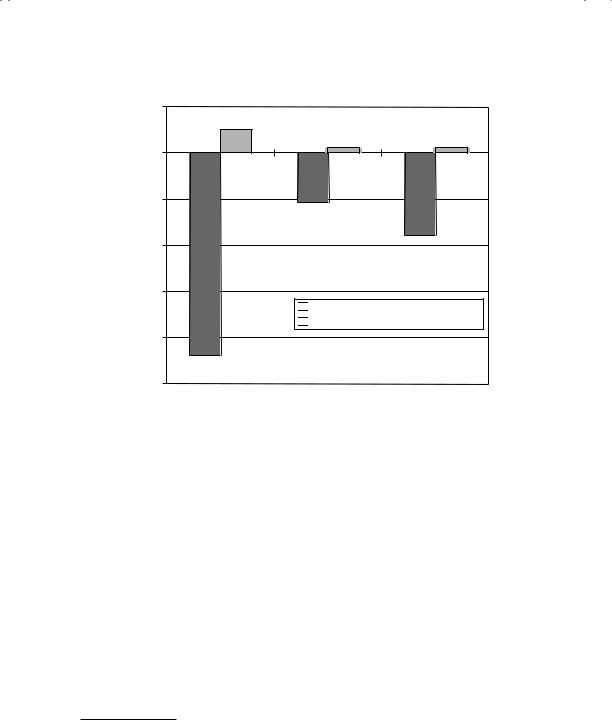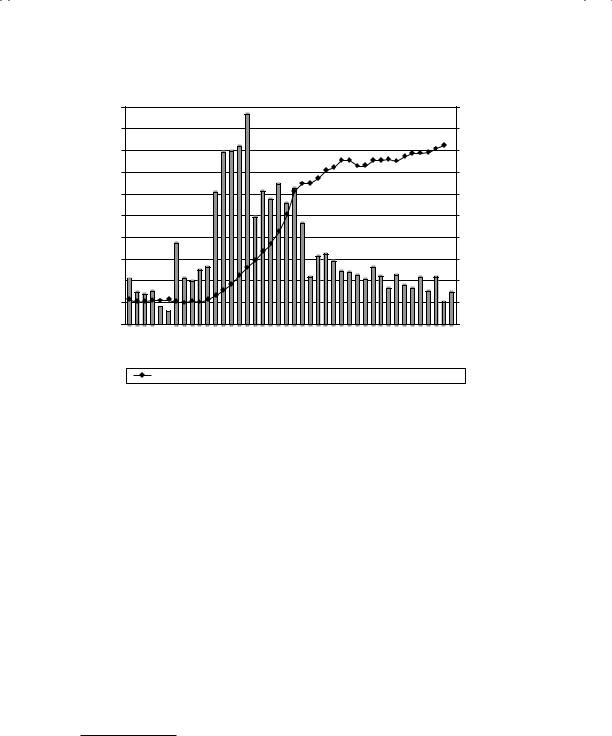
aswath_damodaran-investment_philosophies_2012
.pdf
310 |
INVESTMENT PHILOSOPHIES |
that companies could use to push their stock prices up. The flaw with this logic, of course, is that it assumes that the price-earnings ratio will not change for the company as it pays cash out to stockholders and makes itself a riskier enterprise.
C o r p o r a t e G o v e r n a n c e Both conglomerate discounts and underleverage are manifestations of a larger problem, which is that managers at some publicly traded companies do not put stockholder interests first. While you can fashion specific solutions to these issues, they may not be sufficient in a firm where the source of the problem is poor management. For such firms, the only long-term solution to value generation is a new management team.
Corporate Governance and Value In most publicly traded firms, there is a separation between the ownership of the firm (stockholders) and the managers of the firm. Corporate governance is a term that we use to capture how accountable managers are to stockholders and the mechanisms in place to make this accountability real. The relationship between corporate governance, in this abstract form, and value is therefore not clearly defined; there is no input in an intrinsic valuation for whether you have a strong and independent board of directors in a valuation model. However, if we view corporate governance as the power that stockholders possess to change bad management, there is a way to bring corporate governance into value by approaching valuation in two steps. In the first step, you value the company run by the existing managers, warts and all, and call this the status quo value. In the second step, you value the company run by optimal management and term this the optimal value. To the extent that there are at least some dimensions where the incumbent managers are falling short, the latter should be higher than the former. The price at which the stock will trade in a reasonably efficient market will be a weighted average of these two values:
Traded value
=(Probability of no change in management) (Status quo value)
+(Probability of change in management) (Optimal value)
With strong corporate governance, the probability of change in management should be high and the stock should trade close to its optimal value; with weak corporate governance, the traded value will approach the status quo value. Any action that improves corporate governance (eliminating differences in voting rights across shares; a new, more independent board; the entry of an activist investor) will therefore increase the traded value.

Graham’s Disciples: Value Investing |
311 |
Gompers, Ishi, and Metrick studied the effect of corporate governance on stock prices by developing a corporate governance index, based on 24 factors, for 1,500 firms; higher scores on the index translated into weaker corporate governance.33 They found that the stocks with the weakest stockholder power earned 8.4 percent less in annual returns than stockholders with the strongest stockholder power. They also found that an increase of 1 percent in the poor governance index translated into a decline of 2.4 percent in the firm’s Tobin’s Q, which is the ratio of market value to replacement cost. In other words, we would expect a firm where stockholders have strong powers to replace and change managers to trade at a higher market value than an otherwise similar firm (in terms of risk, growth, and cash flow characteristics) where stockholders have limited or no power over managers. Corporate governance systems are stronger in some countries than others, and there have been a few studies that have looked at the relationship between firm performance/value and corporate governance across countries. Klapper and Love looked at 14 emerging markets with wide differences in corporate governance and legal systems. They find that countries with weaker legal systems tend to have weaker corporate governance systems. They also conclude that firms with stronger corporate governance systems have higher market values and report better operating performance.34 Finally, they find that the strength of corporate governance matters more in countries with weak legal systems.
While there seems to be support for the argument that companies with better corporate governance trade at higher values, this does not make them better investments per se, since it’s the change in the value that determines returns. In fact, the relationship between corporate governance and returns is weak, with little evidence backing the proposition that investors earn higher returns from investing in companies with stronger corporate governance.
Combining the two sets of findings, though, does offer an opening for investors. If you can invest in companies ahead of an event that strengthens corporate governance (removal of disproportionate voting rights on shares, the election of a more activist board, removal of antitakeover clauses in corporate charters), you will gain from the increase in value that should accompany the change in governance. In an interesting twist on this concept, Bris and Cabolis looked at target firms in 9,277 cross-border mergers, where
33P. A. Gompers, J. L. Ishi, and A. Metrick, “Corporate Governance and Equity Prices,” Quarterly Journal of Economics 118 (2003): 107–155.
34Leora F. Klapper and Inessa Love, “Corporate Governance, Investor Protection and Performance in Emerging Markets,” Journal of Corporate Finance 10 (2004): 703–728.

312 |
INVESTMENT PHILOSOPHIES |
the corporate governance system of the target was in effect replaced by the corporate governance system of the acquirer. Since corporate governance systems vary across countries, this gives the researchers an opportunity to examine the effect on stock prices of changing the corporate governance system. They find that stock prices increase for firms in an industry when a firm or firms in that industry are acquired by foreign firms from countries with better corporate governance.35
Corporate Governance: Value-Enhancement Actions If the key to succeeding with activist investing is to change the way a company is run, strengthening corporate governance is an important first step. The actions that activist investors take to accomplish this range from challenging incumbent managers at annual meetings to trying to acquire the firm with the intent of replacing the top managers.
Proxy contests. At large publicly traded firms with widely dispersed stock ownership, annual meetings are lightly attended. For the most part, stockholders in these companies tend to stay away from meetings and incumbent managers usually get their votes by default, thus ensuring management-approved boards. In some companies, activist investors compete with incumbent managers for the proxies of individual investors, with the intent of getting their nominees for the board elected. While they may not always succeed at winning majority votes, they do put managers on notice that they are accountable to stockholders. There is evidence that proxy contests occur more often in companies that are poorly run, and that they sometimes create significant changes in management policy and improvements in operating performance.36
Changing top management. If you are an activist investor in a firm with incompetent management, how would you go about instituting change? Needless to say, you will not have the cooperation of the existing management, whom you have labeled as not up to the job. If you are able to harness enough stockholders to your cause, though, you may be able to
35A. Bris and C. Cabolis, “Corporate Governance Convergence by Contract: Evidence from Cross Border Mergers” (Yale Working Paper No. 02-32, 2002). Firms of English or Scandinavian origin tend to score higher on corporate governance measures.
36J. H. Mulherin and A. B. Poulsen, “Proxy Contests and Corporate Change: Implications for Shareholder Wealth,” Journal of Financial Economics 47 (1998): 279–313. They find that the bulk of the wealth from proxy contests stems from firms that are subsequently acquired or where management is changed.

Graham’s Disciples: Value Investing |
313 |
Abnormal Return
5.00%
0.00%
–5.00%
–10.00%
–15.00%

 Preannouncement Returns
Preannouncement Returns

 Returns on Announcement of Change
Returns on Announcement of Change
–20.00%
–25.00%
Forced |
Normal |
All Changes |
Resignations |
Retirements |
|
|
Type of Management Change |
|
F I G U R E 8 . 1 2 Returns around Management Changes
Source: E. P. H. Furtado and V. Karan, “Causes, Consequences, and Shareholder Wealth Effects of Management Turnover: A Review of the Empirical Evidence.”
Financial Management 19 (1990): 60–75.
increase the pressure on the top management to step down. While some may view the loss of top managers in a company as bad news, it really depends on the market’s perception of the management. The overall empirical evidence suggests that changes in management are generally viewed as good news.37 In Figure 8.12, we examine how stocks react when a firm’s CEO is replaced.
The stock price goes up, on average, when top management is changed. However, the impact of management changes is greatest when the change is forced. Management is more likely to be forced out in the aftermath of poor performance (operating and stock price), and stock prices increase after the change is announced.
37E. P. H. Furtado and V. Karan, “Causes, Consequences, and Shareholder Wealth Effects of Management Turnover: A Review of the Empirical Evidence,” Financial Management 19 (1990): 60–75.

314 |
INVESTMENT PHILOSOPHIES |
16% |
Hostile Takeovers |
|
|
Friendly Takeovers |
|
||
|
|
||
14% |
|
|
|
12% |
|
|
|
10% |
|
|
|
8% |
|
|
|
6% |
|
|
|
4% |
|
|
|
2% |
|
|
|
0% |
|
|
|
–2% |
|
|
|
–4% |
Target ROE – Peer |
Target 5-Year Stock |
% of Shares Held |
|
|||
|
Group ROE |
Return – Peer Group |
by Insiders |
|
|
5-Year Stock Return |
|
F I G U R E 8 . 1 3 Friendly versus Hostile Takeover Target Characteristics
Source: A. Bhide, “The Causes and Consequences of Hostile Takeovers,” Journal of Applied Corporate Finance 2 (1989): 36–59.
Hostile acquisitions. If you cannot get top management to leave the firm, you can actively seek out hostile acquirers for the firm. If others share your jaundiced view of the management of the firm, you may very well succeed. There is evidence that indicates that badly managed firms are much more likely to be targets of acquisitions than well-managed firms. Figure 8.13 summarizes key differences between target firms in friendly and hostile takeovers.38 Note that target firms in hostile takeovers, relative to their peer group, generally have lower returns on equity on projects, have done worse for their stockholders, and have less insider holdings than target firms in friendly takeovers. Needless to say, the
38A. Bhide, “The Causes and Consequences of Hostile Takeovers,” Journal of Applied Corporate Finance 2 (1989): 36–59.

Graham’s Disciples: Value Investing |
315 |
payoff to being the stockholder of a firm that is the target of a hostile takeover is large.
C l a s s e s o f A c t i v i s t I n v e s t o r s
If the essence of activist investing is that you invest in a poorly managed company and then try to get it to change (by either running it yourself or putting pressure on management), it follows that activist investors can take different forms. Some are lone wolves, entrepreneurs on the lookout for turnaround candidates; others are institutional investors (mutual funds and pension funds) that don’t want to follow the “sell and move on” strategy; and still others are hedge funds or private equity funds.
L o n e W o l v e s In the movie Wall Street, Michael Douglas plays the role of a hostile raider, proclaiming that greed is good and eager to profit at any cost. His character was modeled on Ivan Boesky, one of many individuals during the 1980s who raised the profile of activist investors by targeting public companies, sometimes taking them over and at other times just scaring managers enough to get them to change their ways and profiting along the way. While Hollywood has since found other bogeymen in the finance business, Bill Ackman, Carl Icahn, and Nelson Peltz are just a few highprofile investors who continue the practice.
These successful raiders share some common features. The first is that they target the right companies, picking firms that have underperformed their peer groups both in profitability and in stock price performance. The second is that they are not shy about rocking the boat, challenging incumbent managers on their fundamental business decisions: where they invest, how they raise funds, and how much they return to stockholders. The third is that they are willing to do the legwork and expend the resources required to contest management, from gathering proxies to trying to build alliances with unhappy investors and portfolio managers. The fourth is that they are persistent, willing to fight for long periods to accomplish what they set out to do, while recognizing when to give up (or give in) on fights that they cannot win.
I n s t i t u t i o n a l A c t i v i s t s Activist investing does not come naturally to mutual funds and pension funds for many reasons. Its confrontational style riles managers in targeted firms (who may be clients or potential clients for mutual fund firms in other businesses), and it requires time and resources that fund managers who have a hundred or more companies in their portfolios are unwilling to expend. Consequently, the typical professional money manager remains a passive investor who votes with his or her feet, selling stock in companies that he or she does not like and moving on.

316 |
INVESTMENT PHILOSOPHIES |
There are and have been some exceptions to this general rule. The California Public Employees’ Retirement System (CalPERS) was one of the first funds to take an activist investing stance in the mid-1980s. Not only did it generate an annual list of worst-managed firms in the United States, but it then took positions in these firms and sought to change the way they were run. In the past two decades, other mutual funds have taken on the activist role, but they remain a small subset of the overall universe of funds.
A c t i v i s t H e d g e F u n d s / P r i v a t e E q u i t y F u n d s The explosion in private equity and hedge funds in the past few decades has opened a new front in activist investing. A subset of private equity funds have made their reputations (and wealth) at least in part by investing in (and sometimes buying outright) publicly traded companies that they feel are managed less than optimally, changing the way they are managed, and cashing out in the marketplace.
A key difference between these funds and the other two classes of activist investors is that they have an ambivalent relationship with incumbent managers. Rather than challenge them as incompetent, they often team up with managers in taking public companies into the private domain, at least temporarily. In effect, they are arguing that the key reasons for poor management are the separation of ownership from management (prevalent at most publicly traded companies) and the pressures brought to bear by investors and analysts on public companies to deliver results quickly.
E m p i r i c a l E v i d e n c e o n A c t i v i s t I n v e s t i n g
So, what types of firms do activist investors target? Once they take large positions in these firms or take them over, do they live up to the stereotype of short-term, greedy investors who destroy businesses, or do they have a more positive impact on how companies are run? Finally, do activist investors make large profits, after adjusting for the risks that they are exposed to?
W h o m D o T h e y T a r g e t a n d W h y ? If activist investors hope to generate their returns from changing the way companies are run, they should target poorly managed companies for their campaigns. Institutional and individual activists do seem to focus on poorly managed companies, targeting companies that are less profitable and that have delivered lower returns than their peer group. Hedge fund activists seem to focus their attention on a different group. A study of 888 campaigns mounted by activist hedge funds between 2001 and 2005 finds that the typical target companies are small-cap to mid-cap companies, have above-average market liquidity, trade at low price-to-book value ratios, are profitable with solid cash flows, and pay their

Graham’s Disciples: Value Investing |
317 |
50.00% |
|
|
|
|
45.00% |
|
|
|
|
40.00% |
|
|
|
|
35.00% |
|
|
|
|
30.00% |
|
|
|
|
25.00% |
|
|
|
|
20.00% |
|
|
|
|
15.00% |
|
|
|
|
10.00% |
|
|
|
|
5.00% |
|
|
|
|
0.00% |
|
|
|
|
Undervaluation |
Capital |
Business |
Sale of Target |
Governance |
|
Structure |
Strategy |
Company |
|
F I G U R E 8 . 1 4 Motives for Hedge Fund Activism
Source: A. Brav, W. Jiang, and H. Kim, “Hedge Fund Activism: A Review,” Foundations and Trends in Finance, NOW (2010).
CEOs more than other companies in their peer group. Thus, they are more likely to be undervalued companies than poorly managed ones. A paper that examines hedge fund motives behind the targeting provides more backing for this general proposition in Figure 8.14.39
In summary, the typical activist hedge fund behaves more like a passive value investor looking for undervalued companies than like an activist investor looking for poorly managed companies.
W h a t D o T h e y D o ? The essence of activist investing is that incumbent management is challenged, but on what dimensions? And how successfully? A study of 1,164 activist investing campaigns between 2000 and 2007 documents some interesting facts about activism:40
Two-thirds of activist investors quit before making formal demands on the target. The failure rate in activist investing is very high.
39A. Brav, W. Jiang, and H. Kim, “Hedge Fund Activism: A Review,” Foundations and Trends in Finance, NOW (2010).
40N. Gantchev, “The Costs of Shareholder Activism: Evidence from a Sequential Decision Model” (SSRN Working Paper 1646471, 2011).

318 |
INVESTMENT PHILOSOPHIES |
Among those activist investors who persist, less than 20 percent request a board seat, about 10 percent threaten a proxy fight, and only 7 percent carry through on that threat.
Activists who push through and make demands on managers are most successful when they demand the taking private of a target (41 percent success rate), the sale of a target (32 percent), restructuring of inefficient operations (35 percent), or additional disclosure (36 percent). They are least successful when they ask for higher dividends/buybacks (17 percent success rate), removal of the CEO (19 percent), or executive compensation changes (15 percent). Overall, activists succeed about 29 percent of the time in their demands on management.
The review paper on hedge fund activism, that we used as the basis for Figure 8.14, finds that the median holding for an activist hedge fund is 6.3 percent, and even at the 75th percentile the holding is about 15 percent. Put differently, most activist hedge funds try to change management practices with well below a majority holding in the company. The same paper also documents an average holding period of about two years for an activist investment, though the median is much lower (about 250 days).
In general, the market reaction to activist investors, whether they are hedge funds or individuals, is positive. A study that looked at stock returns in targeted companies in the days around the announcement of activism, came up with the summary results that are reported in Figure 8.15.
Note that the bulk of the excess return (about 5 percent of the total of 7 percent) is earned in the 20 days before the announcement and that the post-announcement drift is small. There is also a jump in trading volume prior to the announcement, which does pose interesting (and troubling) questions about insider information and trading. The study also documents that the average returns around activism announcements have been drifting down over time, from 14 percent in 2001 to less than 4 percent in 2007.
Following through and looking at companies that have been targeted and sometimes controlled by activist investors, we can classify the changes at these companies into the four groups that we listed earlier (as potential value enhancement):
1.Asset deployment and operating performance. There is mixed evidence on this count, depending on the type of activist investor group looked at and the time period. Divestitures of assets do pick up after activism, albeit not dramatically, for targeted firms. There is evidence that firms targeted by individual activists do see an improvement in return on capital and other profitability measures relative to their peer groups, whereas firms targeted by hedge fund activists don’t see a similar jump in profitability measures.

Graham’s Disciples: Value Investing |
319 |
|
9% |
|
|
8% |
|
Return |
7% |
|
6% |
||
Hold |
5% |
|
-and- |
4% |
|
Buy |
3% |
|
Abnormal |
||
2% |
||
|
1% 

0% |
–1% |
20 |
18 |
16 |
14 |
12 |
10t– t– t– t |
2 |
Filing |
||||
t– |
t– |
t– |
t– |
t– |
t– |
8 |
6 |
4 |
– |
|
|
|
|
|
|
|
|
||||||
|
|
|
|
|
|
|
|
|
13D |
|
|
200%
180%
160%
140%
120%
100%
80%
60%
40%
20%
0%
|
t+8 |
0 |
6 |
|
t+2 t+4 t+6 |
|
t+12t+14t+1 t+18t+20 |
||
t+1 |
||||
Abnormal Buy-and-Hold Return (Left)  Abnormal Share Turnover (Right)
Abnormal Share Turnover (Right)
Abnormal Share Turnover Relative to (t–100, t–40)
F I G U R E 8 . 1 5 Excess Returns and Trading Volume around Activism Announcements
Note: The solid line (left axis) plots the average buy-and-hold return around the Schedule 13D filing, in access of the buy-and-hold return of the value-weight market, from 20 days prior the 13D file date to 20 days afterward. The bars (right axis) plot the increase (in percentage points) in the share trading turnover during the same time window compared to the average turnover rate during the preceding (−100, −40) event window.
Source: A. P. Brav, W. Jiang, F. Portnoy, and R. S. Thomas, “The Returns to Hedge Fund Activism” (SSRN Working Paper 1111778, 2008).
2.Capital structure. On financial leverage, there is a moderate increase of about 10 percent in debt ratios at firms that are targeted by activist hedge funds, but the increase is not dramatic or statistically significant. There are dramatic increases in financial leverage at a small subset of firms that are targets of activism, but the conventional wisdom that activist investors are proponents of outlandishly high debt ratios is not borne out in the overall sample. One study does note a troubling phenomenon, at least for bondholders in targeted firms, with bond prices dropping about 3 to 5 percent in the years after firms are targeted by activists and a higher likelihood of bond rating downgrades.41
41H. Aslan and H. Maraachlian, “The New Kids on the Block: Wealth Effects of Hedge Fund Activism on Bondholders” (working paper, University of Houston, 2009).
